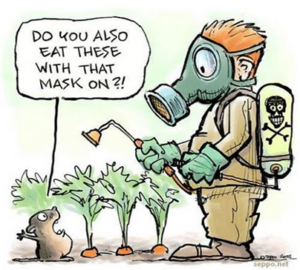
Did you know that RoundUp is adding to the extreme rise in ticks?No one wants weeds – but Round Up is NOT the answer! But I’ll bet it will surprise you to learn that the blanketed use of Round Up is actually adding to the widespread epidemic of tick-borne diseases. Sierra Club research and findings: The common Western Fence Lizard eats ticks by the millions! Wherever the lizards abound, the population of disease-carrying ticks are low. Fewer lizards result in more disease carrying ticks. Not only do these lizards eat ticks – but when ticks bite the lizards – the blood from the lizard actually eliminates the Lyme disease in the tick. The tick lives but its blood is cleansed of the Borrelia bacteria and it no longer poses a Lyme disease risk. In areas with Western Fence Lizards, about 5% of ticks carry the disease, while in other areas 50% of ticks harbor the disease. The recent rise in tick-borne diseases spreading across the U.S. is alarming. Global warming is a suspected accelerator, but one needs to also seriously consider that the over-use of pesticides such as Round Up is exponentially fueling the fire. Then there are the bees and the butterflies…
Direct Toxic Effects of Glyphosate on Honey bees: A 2014 Study entitled; “Effects of field-realistic doses of Glyphosate on honeybee appetitive behavior”shows that Glyphosate can disrupt learning behaviors in honeybees and severely impair long-term colony performance. The scientists who conducted the study used field-realistic levels of glyphosate, similar to what honeybees may encounter on a farm growing GMOs. Indirect Toxic Effects of Glyphosate on Monarch Butterflies: Glyphosate’s in direct effect on invertebrates due to habitat destruction is also exemplified by the decline of Monarch butterfly numbers. A 2011 study led by Isabel Ramirez at Universidad Nacional Autonoma found that Monarch butterfly migration abundance had been declining over the previous 17 years – coinciding with the significant and widespread usage of glyphosate. Do you know what a half-life is?That is the time it takes for something to break down half way from its original concentration levels. Example: If a half-life of a toxin is 30 days – that means 30 days after exposure there is still half the amount of the toxin present. 30 days after that there is still ¼ amount left, and 30 more days after that there will still be 1/8 of the toxin present. The exact time depends upon many variables including the amount and strength of the Roundup in the soil. Glyphosate and its metabolites can persist for many years in the environment, depending on conditions. A number of studies have shown that, depending on conditions, Glyphosate and its metabolites can persist for many years in the environment. Nomura and Hilton (1977) reported glyphosate half-lives of up to 22 years in soils with pH<6. What about the concerns for ourselves and our pets…
|
|
|


